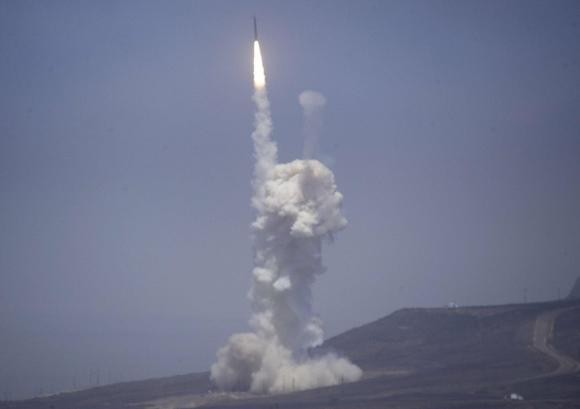Clunky US Missile Defense System Passes Simulation Drill
| M. Morelos | | Jun 23, 2014 02:43 AM EDT |
(Photo : Reuters) A missile was launched at Vanderbild Air Force Base in California to intercept a dummy missile during Sunday's simulation run
Like Us on Facebook
So far, so good.
The U.S. missile defense system successfully passed its first simulation run in six years over the weekend, intercepting an enemy missile over the Pacific, according to the U.S. Defense Department.
The U.S. Ground-based Midcourse Defense (GMD) system, run by Boeing Co., has been in trouble the past few years and last week's testing showed the U.S.'s sole defense against long-ranged ballistic missiles can still defend their mainland against external threats.
"This is a very important step in our continuing efforts to improve and increase the reliability of our homeland ballistic missile defense system," Missile Defense Agency (MDA) Director Vice Admiral James Syring said.
The test came after the system failed to intercept a dummy missile in five of eight previous tests since the system was deployed in 2004. The Bush administration had ordered the deployment of the missile system as a countermeasure against the growing threat of North Korea.
Syring maintained that the agency will keep on checking the entire system, as well as ground-based interceptors and the U.S.'s overall defense system, to ensure its reliability in the face of different threats.
Last week, the Pentagon ordered the restructuring of its US$3.48 billion contract with Boeing for the management of the missile defense system, putting more weight on its maintenance and reliability.
Had the test resulted into another failure, Syring said it would have forced the Pentagon to reevaluate its plans to beef up the existing missile defense system by adding 14 more interceptors to the 30 already placed in silos in Alaska and California.
The test last week had a ground-based interceptor launched from Vandenberg Air Force Base in California hit a target that was built by Lockheed Martin Corp. The dummy target was launched on Kweaialein Atoll in the Republic of the Marshall Islands, the Pentagon and Lockheed said.
The manufacturer explained that the unarmed 45-foot (14-meter) target had been configured to mimic the capabilities of missiles launched from the ground that can travel 3,000 km to 5,000 km (1,800 to 3,400 miles).
Components involved in the test also performed as designed, the Pentagon said. Officials will continue to assess the performance of the system by using all data obtained during the test.
TagsUS Missile Defense System, Ground-based Midcourse Defense, Pentagon-Boeing contract, North Korea threat
©2015 Chinatopix All rights reserved. Do not reproduce without permission
EDITOR'S PICKS
-

Did the Trump administration just announce plans for a trade war with ‘hostile’ China and Russia?
-

US Senate passes Taiwan travel bill slammed by China
-

As Yan Sihong’s family grieves, here are other Chinese students who went missing abroad. Some have never been found
-

Beijing blasts Western critics who ‘smear China’ with the term sharp power
-

China Envoy Seeks to Defuse Tensions With U.S. as a Trade War Brews
-

Singapore's Deputy PM Provides Bitcoin Vote of Confidence Amid China's Blanket Bans
-

China warns investors over risks in overseas virtual currency trading
-

Chinese government most trustworthy: survey
-

Kashima Antlers On Course For Back-To-Back Titles
MOST POPULAR
LATEST NEWS
Zhou Yongkang: China's Former Security Chief Sentenced to Life in Prison

China's former Chief of the Ministry of Public Security, Zhou Yongkang, has been given a life sentence after he was found guilty of abusing his office, bribery and deliberately ... Full Article
TRENDING STORY

China Pork Prices Expected to Stabilize As The Supplies Recover

Elephone P9000 Smartphone is now on Sale on Amazon India

There's a Big Chance Cliffhangers Won't Still Be Resolved When Grey's Anatomy Season 13 Returns

Supreme Court Ruled on Samsung vs Apple Dispute for Patent Infringement

Microsoft Surface Pro 5 Rumors and Release Date: What is the Latest?










